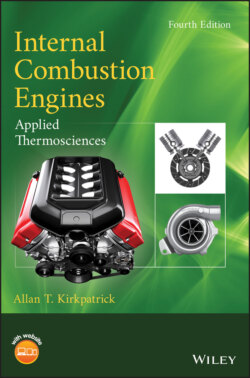Читать книгу Internal Combustion Engines - Allan T. Kirkpatrick - Страница 51
2.5 Limited Pressure Cycle
ОглавлениеModern compression ignition engines resemble neither the constant‐volume nor the constant‐pressure cycle, but rather a cycle in which some of the energy is added at constant volume and then the remaining energy is added at constant pressure. This limited pressure or 'dual' cycle is a gas cycle model that can be used to model combustion processes that are slower than constant volume, but more rapid than constant pressure. The limited pressure cycle also can provide algebraic equations for performance parameters such as the thermal efficiency and imep. The distribution of energy added in the two processes is something an engine designer can specify approximately by choice of fuel, the fuel injection system, and the engine geometry to limit the peak pressure in the cycle.
The cycle notation is illustrated in Figure 2.5. In this case we have the following Equation (2.30) for :
Energy addition
(2.30)
Figure 2.5 The limited pressure cycle (, ).
The expansion stroke is still described by Equation (2.24), provided we write . If we let , a pressure rise parameter, it can be shown that
(2.31)
The constant‐volume and constant‐pressure cycles can be considered as special cases of the limited‐pressure cycle in which and , respectively. The use of the limited‐pressure cycle model requires information about either the fractions of constant volume and constant pressure energy addition or the maximum pressure, . A common assumption is to equally split the energy addition. Results for the case of / = 50 and are shown in Figure 2.6, showing efficiencies and imep that are between the Otto and Diesel limits. For the same compression ratio, the Otto cycle has the largest net work, followed by the limited pressure, and the Diesel. Transformation of and to more useful variables yields
(2.32)
(2.33)
Figure 2.6 Comparison of limited pressure cycle with Otto and Diesel cycles ().
